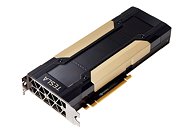- Joined
- Oct 9, 2007
- Messages
- 47,853 (7.39/day)
- Location
- Dublin, Ireland
| System Name | RBMK-1000 |
|---|---|
| Processor | AMD Ryzen 7 5700G |
| Motherboard | Gigabyte B550 AORUS Elite V2 |
| Cooling | DeepCool Gammax L240 V2 |
| Memory | 2x 16GB DDR4-3200 |
| Video Card(s) | Galax RTX 4070 Ti EX |
| Storage | Samsung 990 1TB |
| Display(s) | BenQ 1440p 60 Hz 27-inch |
| Case | Corsair Carbide 100R |
| Audio Device(s) | ASUS SupremeFX S1220A |
| Power Supply | Cooler Master MWE Gold 650W |
| Mouse | ASUS ROG Strix Impact |
| Keyboard | Gamdias Hermes E2 |
| Software | Windows 11 Pro |
NVIDIA updated its compute accelerator product stack with the new Tesla V100s. Available only in the PCIe add-in card (AIC) form-factor for now, the V100s is positioned above the V100 PCIe, and is equipped with faster memory, besides a few silicon-level changes (possibly higher clock-speeds), to facilitate significant increases in throughput. To begin with, the V100s is equipped with 32 GB of HBM2 memory across a 4096-bit memory interface, with higher 553 MHz (1106 MHz effective) memory clock, compared to the 876 MHz memory clock of the V100. This yields a memory bandwidth of roughly 1,134 GB/s compared to 900 GB/s of the V100 PCIe.
NVIDIA did not detail changes to the GPU's core clock-speed, but mentioned the performance throughput numbers on offer: 8.2 TFLOP/s double-precision floating-point performance versus 7 TFLOP/s on the original V100 PCIe; 16.4 TFLOP/s single-precision compared to 14 TFLOP/s on the V100 PCIe; and 130 TFLOP/s deep-learning ops versus 112 TFLOP/s on the V100 PCIe. Company-rated power figures remain unchanged at 250 W typical board power. The company didn't reveal pricing.

View at TechPowerUp Main Site
NVIDIA did not detail changes to the GPU's core clock-speed, but mentioned the performance throughput numbers on offer: 8.2 TFLOP/s double-precision floating-point performance versus 7 TFLOP/s on the original V100 PCIe; 16.4 TFLOP/s single-precision compared to 14 TFLOP/s on the V100 PCIe; and 130 TFLOP/s deep-learning ops versus 112 TFLOP/s on the V100 PCIe. Company-rated power figures remain unchanged at 250 W typical board power. The company didn't reveal pricing.

View at TechPowerUp Main Site




